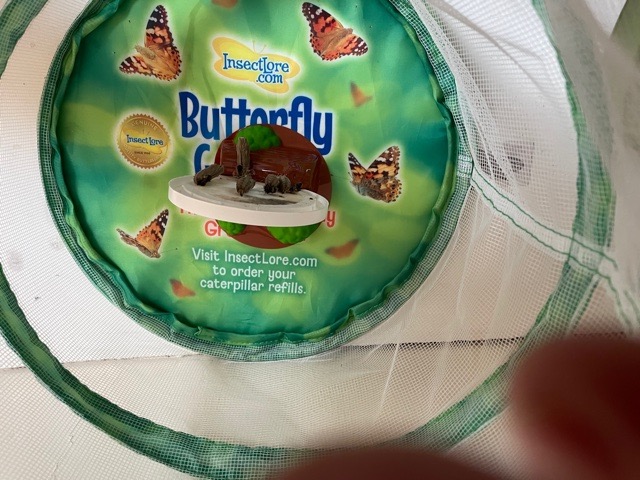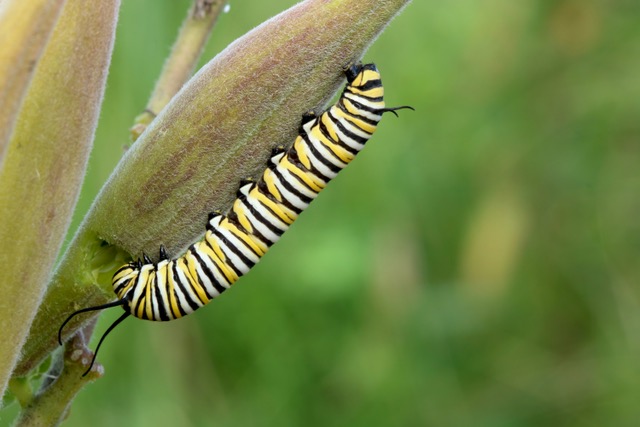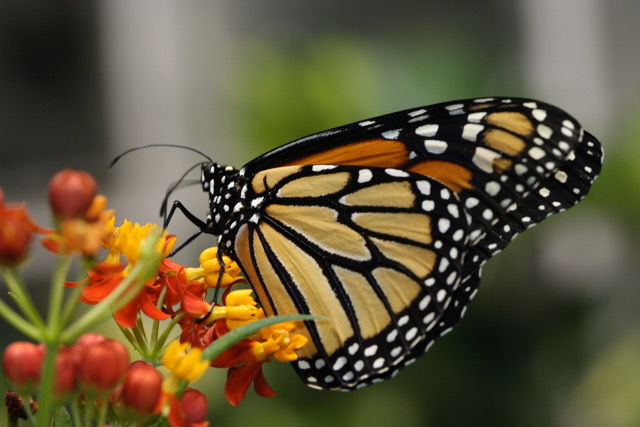For Easter this year, in addition to the obligatory basket of candy, we gave our two grandsons a butterfly farm. It’s an all-inclusive package with five very tiny caterpillars that grow so fast that I swear you can actually see them get bigger if you can sit still for a period of time! Rita and I got to see the transformation ourselves at various points in the process and between visits, the boys kept us updated by texting us pictures.

Watching the process of transformation was quite amazing. At about 10 to 12 days, the caterpillars must choose to stop eating (which they had been doing constantly) and climb up the plastic jar and attach themselves to the lid. At that point they have already shed their exoskeleton four times. They then shed one more time just before they pupate (the boys love this word!) and become chrysalides.
During this stage they have to transition from constantly eating, moving, and growing to simply hanging there, just being present, while being totally transformed! A chrysalis may look like it is resting but an incredible, near-incomprehensible metamorphosis is taking place inside. The caterpillar parts are liquefying and re-arranging to become the cells, tissues, and organs of a butterfly.
And it doesn’t end there. A close friend, Reno, who has been raising and releasing butterflies for many years, explained to me the intense effort required from the newly-formed butterfly to free itself from the chrysalis. Only after a laborious struggle does it finally emerge as one of the most extraordinary and beautiful of all God’s creations!
If you have been following my blog you know I use the word transformation often. Not only has it become a very descriptive word for my personal journey, but also in my professional life. As a counselor, shepherding people through the process of change—often triggered by crisis or trauma—is a large part of the work.
I couldn’t help but look for parallels with the little caterpillars as they made their miraculous journey of transformation. Is the process of change as painful, difficult, and scary for them as it is for us? This shedding of their exoskeletons five times as they grow I expect could be somewhat traumatic! I know that when facing change myself, letting go of my old self has been very difficult and not knowing what the new me would be like has certainly left me hesitant at times.
There is one important difference between us and the caterpillars: we have a choice in our own change process. I don’t think those five caterpillars made a conscious decision to slow down, stop eating, pupate, and participate in the process of becoming a butterfly. However for us it is very different.
We can choose to embrace change by putting ourselves in situations outside our comfort zone where our habits, routines, and perspectives and may be challenged. And even in cases where we can’t choose whether to change—when we are faced with say, an unwanted divorce or serious medical diagnosis that will inevitably shake up and reorder our sense of self—we can choose how we react. Will we resist or embrace the coming change?

Photo by Reno Ungar
I nearly missed out on one of the most transformative experiences of my life because I was afraid of change. At the end of my senior year in high school, my guidance counselor suggested that I might apply to college. This was unexpected. Very few people in my rural coal mining town went to college; my parents certainly hadn’t and didn’t expect me to. I didn’t have outstanding grades, and we couldn’t afford tuition even if I were to somehow get in.
The guidance counselor said there might be one school that might accept me. That school was Williamson College of the Trades and their admission criteria did not primarily rely on past performance; it would be based on their own extensive testing and interviewing. The other unbelievable piece about this school was that if I was accepted, it would be a full scholarship!
I agreed to apply, more to please my counselor than with any real hopes of getting in, especially when I was told the number of young men applying. I was sure that I would be weeded out in the testing and interview process.
However, after each phase of the admissions process, I received the letter notifying me I was selected to move ahead in the process. I had to re-read each letter several times to actually accept that it was happening. When I received the final letter of acceptance I totally panicked!
Taking the scholarship would mean leaving the very small rural community where I was born and raised. I was completely convinced I did not have the academic or social skills to succeed in such a different environment. Risking failure and the public humiliation that would come with it was terrifying. I decided I wasn’t going to accept the offer; it was just too overwhelming!
My mother, a wise and caring, yet challenging person, sat me down for a chat. She expressed her confidence that I had what it took to adapt and succeed at college. Not only did she, as my mother and the person who knew me best in the world, have this opinion, but the admissions panel had come to the same conclusion based on their extensive selection process.
She challenged me to look beyond the potential risks to the possible rewards. “This feels like a once-in-a-lifetime opportunity that could open up an entire new world for you!” she said. “If you don’t seize this opportunity, you may well regret it for the rest of your life. And if it doesn’t work out, you’re no worse off than you were before. You can always come back home and work on a new plan. It’s better to have tried and failed than not to have tried at all.”
Her arguments—and especially her unwavering belief in me—gave me the push I needed to take the risk but I don’t think I have ever experienced that level of fear and uncertainty that I felt that day I left for Williamson! I had no idea how that one decision would totally transform that insecure and confused young man and change the entire trajectory of his life.
My college experience broadened my intellectual horizons, widened my social circle, opened up entirely new career possibilities, and generally increased my confidence and expanded my perspective. Williamson became the chrysalis which allowed me to transform, fortunately not into a butterfly, but rather into a very different person.
Yet, despite that experience and many other personal experiences and the innumerable transformations that I have been privileged to witness in patients and others, it continues to be very difficult and at times frightening for me to break out of my own chrysalis and embrace the transformations that may lie ahead of me. Why is the prospect of change so threatening?

Photo by Reno Ungar
I think there are several reasons why risking the possibility of being transformed is so difficult for us. Much is based on our insecurity. We are very attached to our old selves—our caterpillar selves—because they protect our fragile egos. My career and position make me feel like I’m in charge; they validate my worth and generate resources that make me feel secure. My marriage provides proof of my worthiness and lovability. Even our beliefs and habits are part of our carefully-constructed identities.
It’s frightening for us to begin to accept the fact that none of this actually provides genuine security. In fact, the tighter we hold onto our belief in temporary and external props for our ego, the more dangerous and destructive it is. Genuine peace and security come from knowing that your value is not dependent upon anything you can lose. Our real self—the divine essence that is connected to God and all of creation—is untouchable and indestructible.
Another impediment to seeking transformation is our go-go-go lifestyle. Most of us are too busy working, doing, consuming to have the energy to change—or even realize we need to.
Perhaps like the caterpillar we need to slow down, withdraw from our usual distractions, and then find a quiet place (not necessarily upside down!) to center ourselves and practice mindfulness.
Exploring and embracing mindfulness is the easiest and the most difficult challenge I undertake each day. Some describe it as inner silence or meditation. Whatever you call it, stepping back, even briefly, from the stresses of daily life and becoming more able to live in the present moment gives me perspective and clarity. For me, there is a sense of peace, healing, and anticipating what this sneaky God may be opening up for me next.
If you would like to start “choosing” to bring more transformation in your life, I suggest starting with a daily practice of mindfulness. I firmly believe that the more we are able to do this, the greater the possibility we will experience some level of transformation.
Second, look for smaller, low-risk opportunities for change. It is often by starting out with baby steps that we develop the courage and confidence to try bigger risks. When I have managed to take a risk, regardless of how insignificant it appears, it has often produced some form of transformation in my journey and opened up challenging perspectives, new understandings, new relationships (or revitalized old relationships!), and lead me down paths I never imagined.
The next time you are confronted with change, choose to embrace rather than resist self-transformation and help fill our skies with butterflies!
QUESTIONS FOR DEEPENING THE JOURNEY
- Who do you know that has gone through a significant transformation that you find inspiring? What can you learn from them?
- Do you know anyone who, when faced with a similar opportunity for change, was not able to take advantage of the potential for growth? What do you think made the difference?
- What major transformations, sought or unsought, have you experienced personally? How was your new self different than your old self? Even if you would never have chosen to go through the experience that created the change, do you appreciate the changes it made in you?
- When you are faced with major voluntary change, do you embrace or resist it? Why do you think this is? What has been the result?
- What factors most uphold your sense of identity and self-worth? How hard would it be if those were taken away?
- Do you practice mindfulness? What benefits have you experienced or do you think you might experience?
- What are some small risks that you could take that might prompt some level of self-transformation? Are you willing to commit to one or two? Why or why not?
Banner photo by Reno Unger



Very well written!
so fun to watch that transformation. When the children were young, we found a couple of caterpillars, put them in a jar with lots of food & watched. Fascinating!
cheers from Canada!!
Being for the coal region myself I know how hard it is to leave the security of the cocoon.
Terry,
That one really hit home. If we think back, most of us have likely gone through several periods of transformation that have changed us. It also reminds us of the importance we play in providing positive influence on others. What an eye-opener. Thank you.
Long ago I taught first grade for fifteen years. Each spring we would raise butterflies in our classroom. When the day came to set them free, I taught the children the word “bittersweet”. Even young children can learn important life lessons: when something upsetting happens, look for the joy.
Terry-
As always- you seem to write the words I need to hear at the time. Thank you!
Well written and engaging!